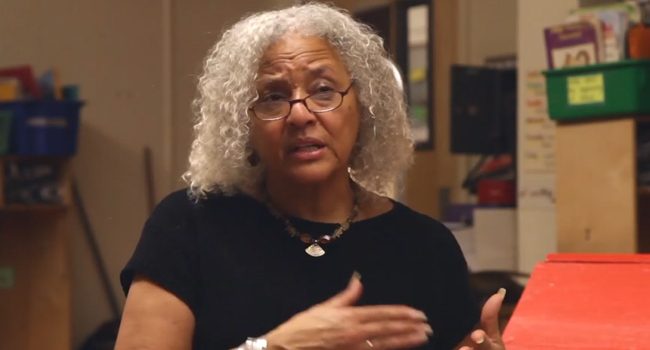No fewer than 8,9600,000 results for “high-quality early learning” appeared in .57 seconds, the time required by Google’s query processor to find the relevant web pages from the company’s database. How comforting to think one might get a handle on this phenomenon.
“What does high-quality early childhood education look like?” was the seventh entry on the first page when I last looked, the headline of an article by Mary Ellen Flannery, who tracks news and trends at the National Education Association. Julie Bullard, of the University of Montana-Western was her main source. She “knows it when she sees it—and so can you,” the text reads.
The third edition of Bullard’s book, a 512-page opus called Creating Environments: Birth to Age 8, was just published by Pearson, the British company best known in the United States for supplying the states with Common Core tests and investments in charter schools. Having seen testing and text book revenues decline, Pearson has been pursuing its business strategies on a global scale to the tune of $5.5 trillion, determined to make high-quality learning available to children in poverty.
The book’s available to cash-starved early education programs and students at a suggested retail price of $103.00, down slightly from the 2014 edition. Also offered is the Enhanced Pearson eText, which “provides a rich, interactive learning environment designed to improve student mastery of content with embedded video and assessments.”
Now, Flannery insists that “nobody, at least not Bullard and her students, want to see 4-year-olds bent over Scantron sheets.” But her piece was published in 2012, before the Maryland State Education Association had suspended a kindergarten readiness assessment, an hour-long exam whose technology challenged nearly 30 percent of the five-year-old students. The surge in test refusal rates across the nation had yet to come.
Still, Pearson continued to ply its wares. After all, as Exxon Mobil CEO, Rex Tillerson, said a couple of years ago in Washington, to which he’ll likely return as Secretary of State: “I’m not sure public schools understand that we’re their customer—that we, the business community, are your customer…What they don’t understand is they are producing a product at the end of that high school graduation.”
Recently, the High Quality Early Learning Project made it into the Google lineup. The brainchild of Beverly Falk, a professor at the City College of New York and the author of Defending Childhood—Keeping the Promise of Early Education, the initiative is backed by the Foundation for Child Development, whose president and CEO, Jacqueline Jones, was the first Deputy Assistant Secretary for Policy and Early Learning in the federal education department under Arne Duncan.
As the U.S. has slowly expanded access to prekindergarten, and academic approaches have filtered down to the primary grades, the early childhood field has yet to fully reckon with the repercussions of market-based education reforms for the development of young children. This project offers a distinctly different vision of teaching and learning, on display in “Walking Alongside the Learner,” the first of four videos documenting exemplary practice in early childhood settings from prekindergarten through second grade.
Yvonne Smith is the star here. An early childhood teacher who began her career in 1974 at a public child care center in the Bronx, she’s spent more than three decades at East Harlem’s Central Park East 1 Elementary School, a haven for child-centered public education founded by Deborah Meier that is struggling to stay true to its progressive ethos.
Smith’s preschool classroom, filled with rich materials for exploration and inquiry, serves as a laboratory for a kind of practice that calls out for revival—one that respects children’s innate capacities, independence, and choice as well as their individual pace of development. The film’s narrative is like a comfortable conversation. Smith welcomes us in to her world with a deliberate, reassuring voice, her teaching strategies organically revealed:
From the first day of school, we have work time. We have two or three choices, just in case your first choice is taken. Amelia is going to pretend. Sebastian, where will you work today? And that says to them that we, the adults in the classroom, feel that they are capable of choosing where they want to work, and choosing how they do that work, and choosing to decide what they’ll use.
Our job as the adults who work with them is to see what questions they may have that they may not necessarily ask… and support them in finding the answers.
Smith is a careful observer, listening to what her preschoolers say, and how they look at things. So does she get a sense of who they are as thinkers and learners and begin to build a community:
Your basic 3-, 4-, and 5-year old really hasn’t changed that much. The world has changed, and the world that they live in has changed, and what they come knowing and having experienced has changed…but how they go about figuring things out and asking questions really hasn’t changed.
It’s important for me to remember that, and to hold on to that, because they still need to have the materials, the time, and the support in making these discoveries on their own, and sharing those discoveries with the other children in the classroom.
The information Smith gleans from the children she gets to know each year has accrued over time, providing knowledge about how the next group of children may learn. Among her many teaching tools, featured in one of the most compelling segments of the video, is a pumpkin, cut open for the children to observe. You can see their synapses firing:
They noticed the difference in it, how liquid started coming out…it began to shrivel, and they wanted to know why. I asked them to take a look…so the responsibility was theirs to see if they could figure out the “why” and the “how”…They saw the flies that were living in it, they noticed the mold that was growing in it…And we talked about decay and decomposition…
Some children noticed other creatures, which they identified as caterpillars, growing in the pumpkin. Smith read them The Very Hungry Caterpillar, by Eric Carle, and they realized that they were witnessing yet another cycle of metamorphosis. One child mentioned the rotten food in the compost kept at home, which was slated for the garden. Other children suggested putting the classroom pumpkin in the school’s garden, where they continued to check on the process of rotting.
In one of the film’s outtakes, called “On Outcomes,” Smith’s eyes fill with tears as she remembers the words of a former student, now in his thirties, who had transferred to Central Park East 1. “My work may not be the best, I may not be the best at this, but it’s mine,” he told her, “and I can get there in my way, supported by the teachers and staff.”
She talks, wistfully, of the reports from the city’s middle schools, delighted with these kids who work with other children, ask the most interesting questions, stick to things and don’t give up, and love learning. “What more can you want than that?” Smith asks.


Quting Rex Tillerson? Really? How about quoting John Taylor Gatto explaining that our educational system in the US was created according to the Prussian model to ‘funnel and control’ the population exactly for the world the Tillerson and his fellow wealth percentile inhabit? Dianne Ravitch’s perspective, along with John Taylor Gatto’s, would be a welcome break to slnted ideological content implicit in an article quoting Rex Tillerson.
You totally missed my irony, Chris. Tillerson’s view is positively loathsome. I cite it in contrast to the philosophy and practice of this brilliant early childhood teacher, who is fully committed to children’s agency and independence, to the power of their voices, and to democratic, progressive education. I invite you to learn more about my ideological biases at my blog, or, for that matter, at Diane’s blog, where she frequently posts my work.